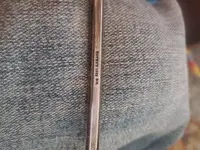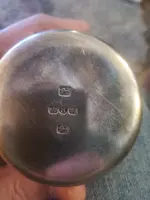Place a neodymium magnet on the smooth surface and let it slide down the metal. The high conductivity of silver will induce a force that will make the magnet slide very slowly. If the metal is plated brass or something else this anomaly won't happen and the magnet will slide off as it would anything else.
This is oft-quoted as a test for distinguishing solid silver from silver plate, but be aware that it’s not wholly reliable. The test does not relate to the high conductivity of silver but relies on it’s lack of ferromagnetism according to ‘Lenz’s Law.’ So, if the underlaying base metal of plated flatware (or the alloy for white metal silver imitations) contains a significant proportion of a ferromagnetic metal the magnet will be slowed.
Copper is not ferromagnetic and neither is zinc, so standard brass (typically 66% copper and 34% zinc) cannot reliably be distinguished by this test. Tin is weakly ferromagnetic, so brass containing tin (technically a bronze) may be distinguished, depending on the proportion of tin in the alloy.
Nickel, however, is ferromagnetic so “German Silver” (typically 60% copper, 20% nickel, and 20% zinc) and its many variants should be distinguishable. So too should “Britannia Metal” or “Vickers Metal” (typically about 92–93% tin, 5–6% antimony, and 2% copper) but less reliably so.
There are other non-ferromagnetic metals and alloys which would also not be distinguishable, but they’re weren’t typically used for flatware prior to the 20th Century.







